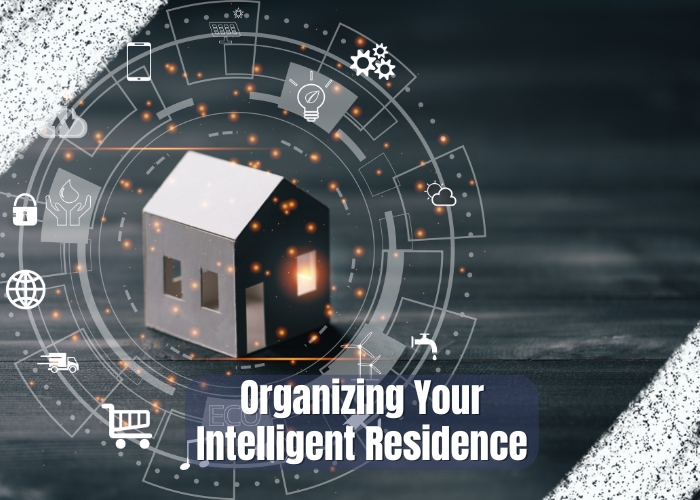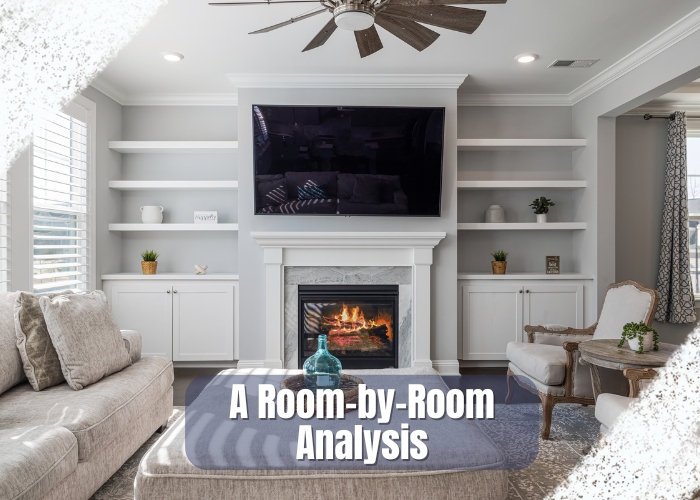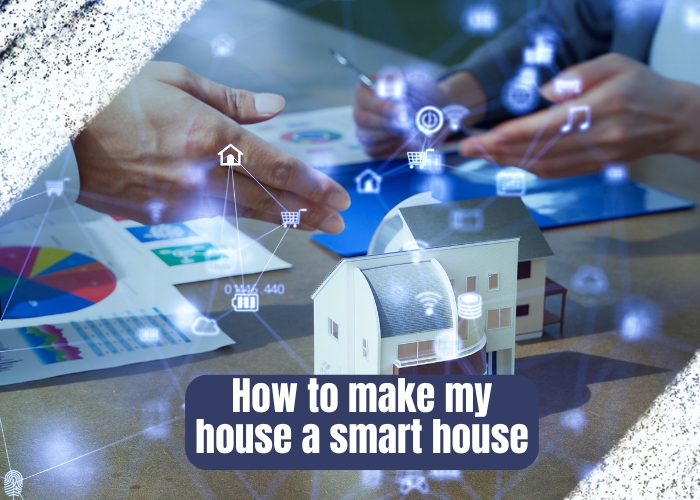There are several advantages to home automation, including convenience, security, and enjoyment. But you might need help figuring out where to start or how to proceed. For example, which should you do first: pick your devices or a smart hub? Which temperature or lighting controls do you start with? so it has some experience bringing gadgets and people together. Let’s talk about How to make my house a smart house.
A Smart Home: What Is It?
A smart home is one where all of the electronics—including lights, locks, appliances, and security cameras—are networked online to exchange data. Voice-activated commands or apps can be used to remotely control, automate, or turn on and off this network of devices.
In what ways may you use this technology in your house?
Common smart home appliances like thermostats and lighting may already be familiar to you. However, a plethora of new gadgets are being released online. The following are some instances of smart house elements and their functions:
- Lighting: You can use your voice to control both interior and outdoor lights. You can even set them to turn on automatically when you get home or to turn on at dusk and turn off right before morning.
- Entryways: Voice commands can be used to lock and unlock doors. With a video doorbell, you can see who is outside your house. The garage door may open on its own as soon as you enter the driveway.
- Kitchen: You may program coffee makers to begin brewing as soon as you wake up. When the cycle is finished, washing machines and dishwashers can notify you.
- Entertainment: You can use your voice to control TVs. It is possible to program stereo systems to activate upon entering a room.
- Family and pets – Intelligent inside cameras can notify you when the children have safely returned from school. With the help of intelligent baby monitors, you may see your kid from another room. Refilling the dog’s bowl while you’re gone from home is possible with smart pet feeders.
- Landscaping: You can have your grass mowed using robotic lawnmowers. (Really, yes.) The weather can be taken into account while adjusting sprinkler systems.
The majority of these gadgets can be operated with voice commands using a smart speaker, and nearly all of them can be operated from your smartphone. It requires some setup, but once everything is in place, it functions practically magically.
There are countless options. Just remember that functionalities differ based on the device’s model and brand.
Organizing Your Intelligent Residence

Although installing a smart home can be an exciting experience, meticulous planning is necessary to ensure that your investment will provide the greatest returns. A smart home might be ideal for you if you’re a tech enthusiast or want to simplify your life a little.
This is a step-by-step tutorial to assist you in setting up your smart home.
Establish Your Objectives and Goals
It’s important to know exactly what you want before diving into the realm of smart
home technology. What do you wish to have?
- Reduce energy costs, streamline everyday chores, and improve home security.
- You can choose the best smart home gadgets by being aware of your objectives.
- It’s easier to set up your smart home when you have a clear plan.
Comfort and Convenience
The convenience and comfort that come with building a smart home are among the main factors that influence this decision. Imagine being able to change the temperature of the room without getting off your sofa or having your coffee ready for you when you get up.
Efficiency in Energy Use
An eco-friendly house can also be smart. Utilizing the appropriate gadgets can help you consume less energy. To save energy, smart thermostats, for instance, adjust the heat or coolness based on your behaviors.
Safety and Security
Reducing stress and anxiety in your life is mostly dependent on feeling safe in your house, and smart homes provide you with more avenues for maintaining safety.
Even when you’re not home, you can see your house thanks to smart cameras. Smart locks allow you to open and close your door from anywhere, and doorbell cameras display who is outside.
How to Construct a Smart House
Here is a closer look at the essential elements for a smart home installation in case you’re wondering how to construct a smart home.
Hubs for Smart Homes
The hub, a device that links and controls all of your smart components, is essential to the smart home control system. Similar to the brain, it ensures that all parts communicate and function as a unit. Consider it the centerpiece of your smart home system.
Connectivity and Networking
Any smart home’s network is its foundation. High-quality mesh networks and routers, such as those from Netgear or Google Nest wifi, offer dependable and long-range connections. This is essential for the smooth operation of all smart devices.
Voice assistants and smart speakers

Our interactions with our homes have been altered by voice control. In addition to playing music, gadgets like Apple’s HomePod, Google Nest Speakers, and Amazon Echo (with Alexa) can also serve as personal assistants by arranging appointments, responding to queries, and managing other smart devices.
Intelligent Lighting
Upgrade your home’s lighting with smart switches and bulbs that come with scheduling, color changing, dimming, and remote control capabilities. Popular options like Philips Hue and LIFX can adjust to your mood and even sync with movies or music.
Thermostats with intelligence
In order to keep you comfortable and conserve energy, devices like the Ecobee and Nest Thermostats modify the heating and cooling according to your routines. They adapt to maintain efficiency whether or not they detect your presence.
Talking robots and voice assistants
Our interactions with our homes are now different, thanks to voice control. As personal assistants, gadgets like Apple’s HomePod, Google Nest Speakers, and Amazon Echo (with Alexa) do more than play music; they can also make reminders, respond to inquiries, and operate other smart devices.
Intelligent Lighting
Install smart switches and bulbs throughout your house to provide remote control, scheduling, color changing, and dimming capabilities. Due to their ability to adjust to your mood and even coordinate with music or movies, Philips Hue and LIFX are well-liked options.
Intelligent Thermostats
Energy-saving devices such as the Ecobee and Nest Thermostats adapt their heating and cooling patterns to your daily routines, ensuring your comfort. They adapt to ensure efficiency based on their knowledge of your presence or absence.
Smart outlets and plugs
Convert conventional appliances to intelligent ones. Any plugged-in device can be remotely controlled and scheduled, or its energy consumption can be monitored with the help of smart plugs from companies like Belkin or TP-Link.
Amusement Platforms
Streaming gadgets, sound systems, and smart TVs can enhance your entertainment experience. Voice control is available for music and video playback with Sonos and Roku systems, which can be integrated with other smart home devices.
Intelligent Appliances
The laundry and kitchen are also becoming more intelligent. These days, it’s commonplace to have refrigerators that keep track of your shopping, ovens that you can preheat on the way home, and remotely operated washing machines. In this revolution of smart homes, LG and Samsung are at the forefront.
Intelligent Curtains and Blinds
Even natural lighting can be automated with smart curtains or shutters. You can program them, operate them from a distance, and even modify them based on temperature using options from companies like Lutron or IKEA.
Creating a Smart Home Design
After discussing the essential ideas behind designing a smart home, let’s get down to business with the actual execution.
We’ll divide the procedure into four main parts in this section:
- Taking into account each area separately, Blending in with the current design, Hiding cables and electronics, User-friendliness, and accessibility.
- Every element is crucial to building a smart home that not only improves your quality of life but also skilfully combines modern technology with classic design elements.
A Room-by-Room Analysis

- Living Room: Let’s begin in the center of your house. Think of intelligent lighting that adapts to various activities and emotions. Make sure you can use voice commands or a single remote control to operate your entire entertainment system, including the TV and speaker.
- Kitchen: Voice-activated products, such as smart ovens or coffee makers, can improve your culinary experience. Put in a touchscreen hub so you can quickly access timers and recipes.
- Make sure your bedroom is cozy and peaceful first. The temperature may be adjusted via smart thermostats to ensure a restful night’s sleep, and voice-activated alarm clocks can gently wake you up.
- Bathroom: As you get ready in the morning, smart mirrors with integrated monitors can offer helpful information. For a spa-like experience, think about installing a shower system with adjustable water settings.
- At-home workspace: Invest in intelligent lighting and ergonomic furniture that adjusts to your demands. Your workstation is more secure when you use smart locks.
Tasks for Regular Maintenance
Make these regular inspections to ensure your smart home is operating efficiently:
- Updates: Make sure that the devices and firmware on your smart home control system are up to date on a regular basis. This may improve and secure their operation.
- Wifi Health: Occasionally turn your router on and off. Your internet may function better as a result.
- Hygienic gadgets: To ensure optimal functionality, ensure that all devices—particularly sensors and cameras—are cleaned and dust-free.
- Change Passwords: You can keep your smart home secure by periodically changing your passwords.
The Final Word
Constructing a smart home is a thrilling move toward contemporary life. Determine your goals first, whether they be security, comfort, or energy conservation.
Selecting a system such as Google Home or Alexa and ensuring that all of your smart home’s gadgets communicate with one another is crucial. Keep your spending under control, start with the essentials, and gradually expand your smart home setup.

